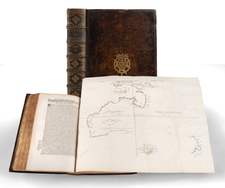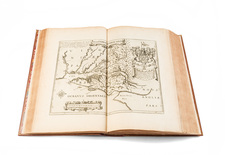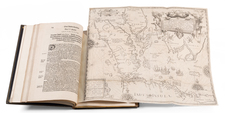The Best Early English Description of New York
With Descriptions of Florida, the West Indies, California, and New Mexico
The Anson Phelps Stokes Copy
A very rare English work on the American colonies, especially notable for its early description of New York and Florida. Stevens states that this work "should find a place in every collection of the so-called Eliot Tracts, for herein is contained the embryo idea or suggestion that Parliament should recognize the benefits to be derived by the colonies from cultivating the friendship of the Indians." The speech by Benjamin Rudyerd urges the establishment of a company for West Indian settlement and commerce to counter Spain's presence there. On New Amsterdam, Castell writes "Neare of this great [North] River, the Dutch have built a Castle... for their more free trading with many of Florida, who usually come down the River Canida, and so by land to them. A plaine proofe, Canida is not far remote."
William Castell was a Puritan clergyman and ardent proponent of Protestant overseas expansion. His Short Discoverie was, to an extent, an echo of Richard Eden’s plea, made almost a century earlier (1555), for a concerted English effort to Christianize the American Indians as one means of countering the power and influence of Spain in the New World. Like most early seventeenth-century English anti-Catholics, Castell believed that Spain was still the arch-enemy, and that any effort to reduce the sources of Spanish power on both the continent and in America could only serve to the advantage of England and the Protestant religion. In reality, Spain had declined to the status of a second-rate power, while the French and the Dutch were becoming England’s antagonists on the continent and overseas, a fact that few Englishmen recognized at the time.
Castell’s book provided a brief history and geography of America from Peru to Canada, including the islands of the West Indies, based upon a number of sources---not all of which were particularly accurate. Its primary importance, however, lies in the fact that its text, along with the Petition to Parliament (first printed in 1641), presented the religious, political, and economic arguments for the propogation of the Gospel in America, and was influential in increasing parliamentary interest in the developing English empire. It is probable that Castell’s work also influenced Cromwell’s “Grand Design” for promoting English imperialism in the West Indies, and for the subsequent decision to translate and publish the celebrated “Indian Bible” of John Eliot. - Howell.
George Watson Cole states the following in the Church catalogue:
Castell had a very good idea of the topography of New Netherland, which he had doubtless acquired from Dutch maps; but his conceptions of distances and latitude were very indefinite. Separate chapters are given to New England, New Netherland, Virginia, Florida, Cuba, Nova Francia, etc. Of New Netherland he says that it "differeth not much from New England, only I must in these foure things give it the precedency, that the land in generall is richer, the fields more fragrant with flowers, the timber longer, and therefore more fit for building and shipping, the woods fuller of Bevors, and the waters of Salmon and Sturgeon." At the end, the author promises "another Booke" with "the Southerne Description of America," which never appeared.
New Mexico and California
The book contains an interesting overview of the English Plantations for the time, and covers Spanish settlements in the West Indies. Most bibliographers seem to have overlooked the final section under "Galaecia," which includes quite early descriptions of New Mexico and California, especially for an English book of the time. Not in Cowan or Wagner's Spanish Southwest.
- Newfoundland
- Nova Francia
- New England
- New Netherland
- Virginia
- Florida (pages 29-34). A concise summary of the early Spanish voyages to Florida, beginning in 1512, focusing on De Soto: "...the most remarkable was undertaken by Fernando a Soto, from the yeare 1536, unto 1541." On the native people of Florida: "The Inhabitants are of a tawny colour, of great stature, and well compacted bodies, very expert Archers, exceeding active, fierce and manly in their manner of assault... They hate the Spaniard extreamly, more willingly they entertaine and joyn their forces with the French, and other Christian Nations against them."
- Cuba
- Hispaniola
- Lucaick Islands
- Porto-Rico
- Burmudos
- Caribb Islands
- Guiana
- Margarita, Coetz, Cobana
- Cubana and Venezuella
- Panima
- Galaecia [including refrences to Benavides, Niza, Gomara, Herrera, Gonzalez de Mendoza; also California and Nueva Viscaya]: "I am now come to Nova Galaecia to the West of Mecoachan, bounded to the West with the sea of California; but to the North and North-west, though large and spatious Countryes are discovered, yet it is concluded by the learned in this kind, that there resteth much more to be discovered... California, though it be esteemed to be of very large extent, yet hath it not been as yet discovered. Sir Francis Drake in his admirably happy voyage, compassing the World, fell upon it (and was from such Savages as there inhabiting more kindly entertained then he expected) he took possession thereof in the name of the Queen of England: A good presage, that the most remote parts being seized upon the rest shall be possessed by us, in his good time who is the onely disposer of the earth... The Inland Provinces Zacatecas, Topia and Nova Biscaya [in the early years of settlement, Nueva Viscaya encompassed most of the area north of Zacatecas] lying between the Californian sea and the upper part of the gulf of Mexico: Between Bullacan and Panuco...containe much ground, more rich then any, in regard of the many silver mines...Cibola, Quivara and Nova Mexico, three other Provinces, are yet much more to the North by many degrees... A Fryar Marke de Niza... telleth wonders concerning the riches, the stately buildings, the most pleasant inviting habitations in Cibola: But Vazquez de Coronado, who thereupon was presently sent away to make a further discovery with 150 horse and 200 foot, finding nothing worth his great travailee and cost, certified so much to the Viceroy..."
Provenance
Henry Stevens, bound by W. Pratt for H. Stevens, 1860, with binder's neat dated typographic stamp on verso of front free endpaper. His sale, "Bibliotheca Americana," Puttick and Simpson, 7 March 1861, lot 514.
Anson Phelps Stokes (1838-1913), with his bookplate. Member of the prominent Phelps Stokes family, and father of Rev. Anson Phelps Stokes (who inherited the present book) and Isaac Newton Phelps Stokes - the author of The Iconography of Manhattan Island (1915-1928). His sale, Parke-Bernet, New York, 15 November 1948, lot 58.
Rarity
An extremely rare book. Only one other example of this book has sold at auction in the last 45 years; and another offered by Howell in a 1980 catalogue at $1750.













![[ British Colonies in North America & Caribbean ] L'Amerique Angloise, ou Description des Isles et Terres du Roi d'Angleterre dans l'Amerique, Avec de nouvelles Carte de chaque Isle & Terres](https://storage.googleapis.com/raremaps/img/small/102812.jpg)
![(American Revolution - Virginia Privateering) Manuscript Document Concerning the American Privateer Grand Turk, Captured Near Scotland's Fair Isle by Michael Griff [The Capt. of the Privateer Michael Griff declares as follows ...]](https://storage.googleapis.com/raremaps/img/small/82328.jpg)
![De La Democracia en la América del Norte, Lecointe, Paris 1837 [with map:] Mapa para la obra intitulada Democracia en America](https://storage.googleapis.com/raremaps/img/small/101984.jpg)
